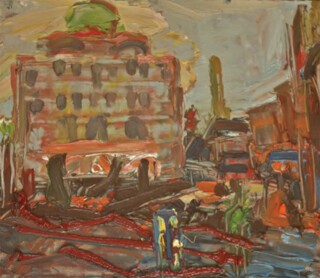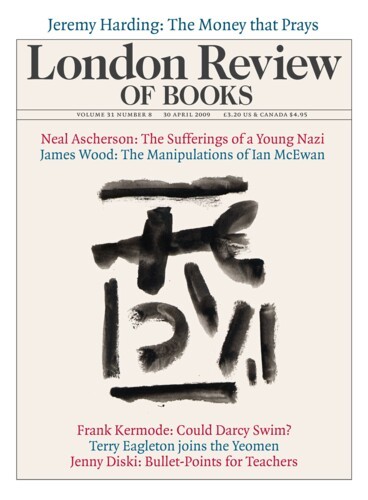Since 1901 the wide, round-arched entrance in the Whitechapel Gallery’s front on Whitechapel High Street has been open to passers-by; there isn’t even a step to interrupt the level way from footpath to gallery. It has never been intimidating. It was made for the use and pleasure of people who live and work nearby, but it is also – and always has been – an institution of national standing.
Now, a little more than a century after its opening, it has taken over the slightly older Passmore Edwards Library next door. Passmore Edwards, a self-educated social reformer and newspaper proprietor, provided money for the gallery – he had funded other, similar buildings. He wanted his name on this one. Henrietta Barnett, the driving force behind the project, objected and what would, it seems, have been the front’s major decorative element – a terracotta panel by Walter Crane showing Art attended by Labour, Time, History, Poesie, Truth and Beauty, was excluded – which explains the blank painted space between the two attached towers that frame the upper storey. (The design for Crane’s panel is illustrated in The Buildings of England, London 5: East.) You would hardly guess anything was missing; the building is a showpiece, Whitechapel High Street’s strongest and most interesting frontage. The architect, Charles Harrison Townsend, designed similar heavily moulded round-arched entrances for the Bishopsgate Institute and the Horniman Museum.
The spaces inside were much less emphatic – almost industrial in their plainness. Discreetly elegant improvements in 1988 and the new galleries in what was the Passmore Edwards Library fit well: fairly minimal modernism and Victorian frugality merge. The mostly top-lit spaces are kind to works of art and close in scale and feeling to the made-over warehouses and workshops that artists looking for studio space have turned to, over the last fifty years or so. Barnett and Passmore Edwards might have been surprised to know that thousands of studios and dozens of galleries have sprung up within walking distance of the Whitechapel, many in just the kind of warehouse and light industrial spaces its own galleries resemble. It has come to belong to its neighbourhood in a way a permanent collection, no matter how wonderful, would have been less likely to. Barnett was right to insist that it be the ‘Whitechapel’, not the ‘Passmore Edwards’ gallery (though his name is still there on the library building).
Much of what has been set up to celebrate the reopening looks to the past. In the new gallery on the ground floor you find the tapestry of Guernica, commissioned in 1955 by Nelson Rockefeller and lent in 1985 by the Rockefeller estate to the United Nations in New York. The installation by Goshka Macuga links the painting’s showing at the Whitechapel in 1939 with more recent events. The tapestry, which hung outside the Security Council, was covered over to stop it forming a backdrop when Colin Powell was making the case for the Iraq war – a bronze bust of Powell forms part of the installation. In front of it at the Whitechapel is a circular glass case/ conference table, surrounded by black leather chairs. Among the archive material displayed is a picture of Clement Attlee speaking with Guernica behind him – the display of the picture in 1939 was organised in collaboration with the Stepney Trade Union Council.
In the gallery alongside a new reading room there is currently a display of letters, books, catalogues, paintings and drawings relating to the Whitechapel Boys: the group of Jewish painters and writers (they included David Bomberg, Jacob Epstein, Mark Gertler and Isaac Rosenberg) who met in the library in the early decades of the 20th century. In the space at the top of the old library building is a selection, made by Michael Craig-Martin, of ‘great early buys from the British Council Collection’. The accompanying leaflet makes an unbeatable case for the council’s acumen and usefulness by quoting the prices paid for the works and their subsequent exhibition histories. (Lucian Freud’s portrait of his first wife, Girl with Roses, was bought in 1948 for £157 10s, and has been shown in more than 40 places.)
At the moment the main spaces in the original galleries contain work by the German artist Isa Genzken. Downstairs there are pieces from the 1970s through to the 1990s, including the etiolated sheaves of coloured glass, raised to eye level on tall spindly table-like plinths, that were her response to the skyscrapers of Manhattan, and earlier casts in plaster and concrete. Upstairs are assemblages in which samplings of the profuse confusion of 21st-century material culture – shop-window dummies, wheelchairs, photographs, toys, plastic boots, rubber gloves, trolleys, flowers – are taped, pasted, piled, often in pillar-like conformations. Her installations have resonant names (Empire/Vampire, Oil, Ground Zero), but how one might come to see them the way she sees them is unclear. The incoherence of someone else’s shopping trolley is here madly, strangely, suggestively concentrated into a referential fugue. The state of panic and depression suffered by some people who gain sight after a life of blindness is visited on one. Yet all this stuff is also domesticated with a housewifely orderliness. Assemblages of this kind, which have become common, partly through Genzken’s example, take on both grotty and seemly, implicitly neat, even elegant forms. It may be no accident that of the ones I remember those by women are of the seemly kind – Sarah Sze comes to mind. On the one hand, you can feel that this is a picture of human civilisation overwhelmed by its inability to stop turning raw materials into unnecessary, indestructible things. On the other, some instinctive desire to find a reading in what you see transforms nonsensical combinations into poetic symbols. There is also a row of models of beach shelters – the scale given in one case by a little cut-out figure of a bathing beauty. They are funny and inventive: one can imagine adaptations turning up in proposals for real buildings.
What would the founders have made of it all? A celebratory publication of posters for past exhibitions is a reminder of how well up in the game its directors have been. Art has had a good run here. Labour, Time and History are honoured in the Whitechapel’s commitment to its local constituency. Poesie, Truth and Beauty may now inhabit stranger places than they might have imagined, but the spirit has not died.
Send Letters To:
The Editor
London Review of Books,
28 Little Russell Street
London, WC1A 2HN
letters@lrb.co.uk
Please include name, address, and a telephone number.


